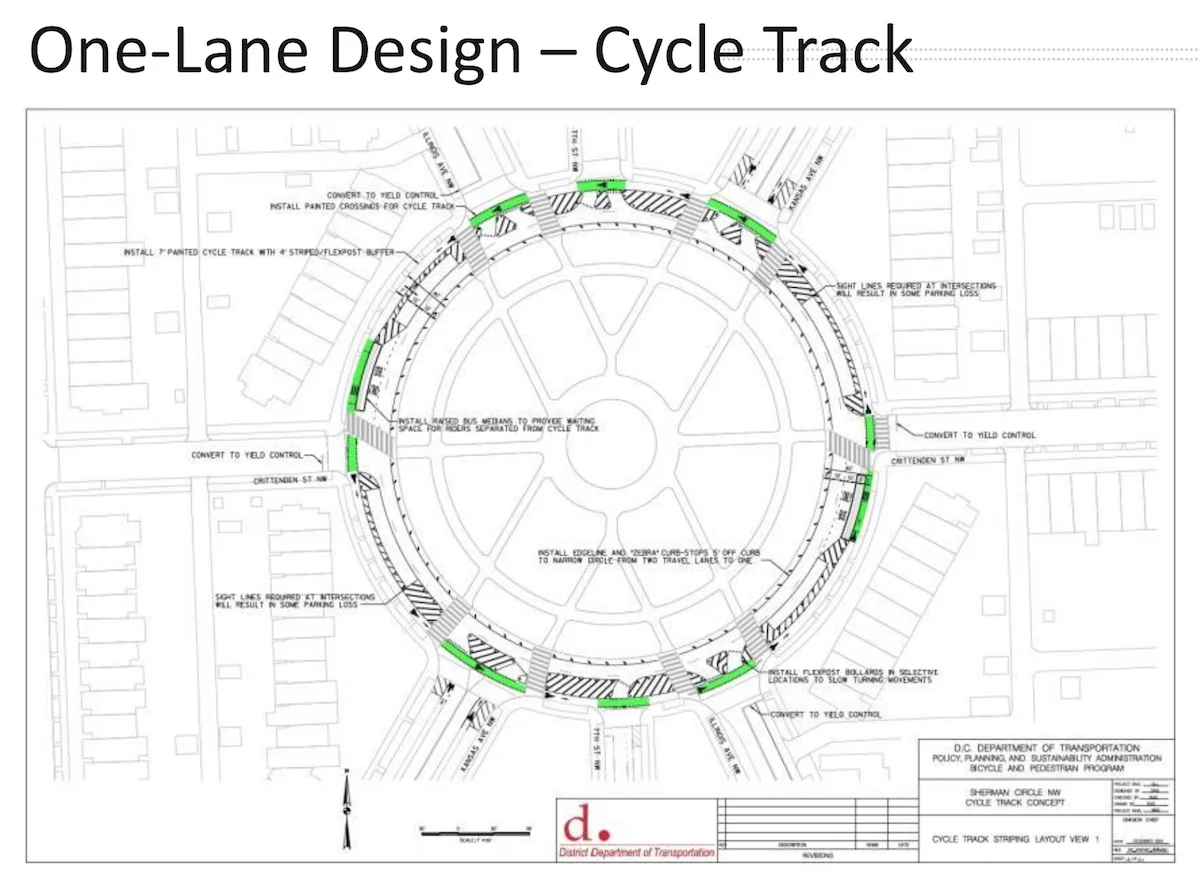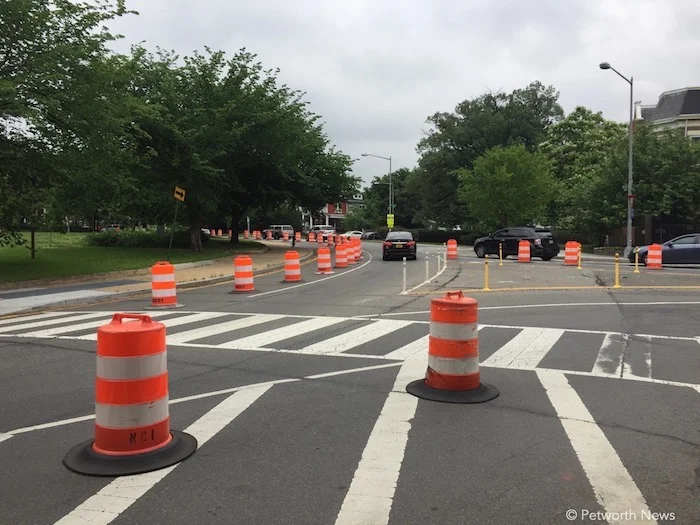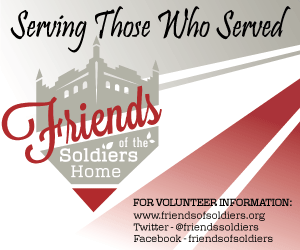Grant Circle "one-lane test" survey shows slim majority leans towards change
/A view of northbound lanes of New Hampshire during rush hour.
By Rachel Maisler & Drew Schneider
It started with a traffic study and a Facebook post. The District Department of Transportation (DDOT) closed one lane of Grant Circle to study traffic patterns and address neighborhood safety concerns. During the test, Petworth News asked readers for their thoughts about the test and boy did we get a response. We followed up with an unscientific survey and 81 people responded to the survey with a diversity of opinion (another 70 or more commented on Facebook) .
As background, the residents living around and near Grant Circle have been pushing to improve vehicle, bicycle and pedestrian safety around the Circle for more than a decade, if not longer. In 2009, DDOT released a Pedestrian Safety Plan that called for some pretty aggressive changes to both Grant and Sherman Circle, as well as other streets in the area. While some of those recommendations were completed, the efforts around the Circles stalled out and nothing happened.
In 2015, Petworth News helped to revive the safety concerns with DDOT via a series of articles, and that summer DDOT added some odd safety bollards to prevent cars from driving INTO the Circle (hasn’t always helped) and painted new lines to theoretically control vehicle ingress and egress from the Circle and improve pedestrian safety (hasn’t really helped).
DDOT said at a recent meeting about Grant Circle that computer modeling of traffic circles is exceedingly difficult, so they turned to a real-world test of Grant Circle to watch traffic patterns and get resident feedback. To help get that feedback, Petworth News ran a survey for just under a week, promoted on Facebook and Twitter.
We worked with HotelsNearDCMetro.com to create a Google Map of Grant Circle during peak travel times that shows traffic (pink to red areas). You can see where traffic currently backs up, and at what time in the YouTube playlists:
Here is a look at the traffic during the one-lane test (May 22nd - May 26th):
And here is what the Circle looked like the week prior for comparison (April 24th - April 28th):
Keep it one lane permanently?
Turns out that 48.8% of residents liked the one-lane test and want to make it permanent, 37.5% did not want to make it permanent, and 13.8% were undecided.
enlarge to see full size
How respondents used the Circle...
Most people who responded to the survey live in Petworth (82%), with the rest in the surrounding neighborhoods. As we expected, the majority of respondents access Grant Circle during either the evening or morning rush hour (and in many cases, both). Many by car, but also by bike or foot – or a combination thereof.
enlarge to see full size
Time of day respondents used the Circle
enlarge to see full size
What type of impact did the Grant Circle traffic calming study have on your daily life?
More than half of respondents said trimming the circle to one lane made them feel safer or even loved it. That said, the other half said the study had no impact, didn’t make them feel any safer, or straight out hated it. 52.6% had a positive opinion on the closure, while 45% had a negative opinion (7.5% said the one-lane test had no impact).
enlarge to see full size
More than Grant Circle was closed that week, though…
One of the issues that might have further impacted the traffic study was that DDOT also closed 5th and Upshur Street on Thursday, May 25th, in the middle of the one-lane test, as well as part of New Hampshire on Wednesday, May 24th. Those two closures would have contributed to traffic piling up during the test. Not sure how DDOT will take that into account when looking at traffic impact.
DDOT did have staff and contractors on-site studying traffic patterns during the test, recording where traffic backed up. From direct observation and talking with some of the DDOT employees on-site during the test, the morning rush-hour saw traffic backing up on southbound New Hampshire and Illinois Avenues, while the afternoon saw traffic backing up northbound on New Hampshire Avenue.
"Hey @ddotdc, who thought closing Upshur & 5th during Grant Circle 1-lane test was a fantastic idea? #alsoraining"
According to one of the engineers we spoke to, part of the traffic on the southound side of New Hampshire (below the Circle) was exacerbated by the close proximity of New Hampshire's two-lanes merging into one lane just before the Circle. He said that, ordinarily, a merge like that would happen below Upshur Street, instead of just north of Upshur immediately before the entrance into the Circle. (Note that New Hampshire northbound is the only ingress or egress point that is two lanes, all other streets entering or exiting are one lane.)
Some who liked the one-lane change said…
“I walk through twice a day (morning/evening rush) and drive through once (evening). Before the experiment, I'd see at least 3 near-miss incidents each week while walking around the circle (through is shorter, but not worth the risk). I haven't seen any this week. The best effect of the barriers is the traffic calming. It feels less chaotic and frantic.” – Anonymous
“The one-lane study did not include a bike lane so it's hard to tell the impact of adding a bike lane to Grant Circle. When using the crosswalk as a pedestrian, I liked that cars were slower in the Circle; it made crossing a little less scary. As a motorist, I tended to avoid the Circle during rush hour due to the tremendous backups.” – Carol Spring
When you're a junior engineer and have to spend your day racing around the Circle watching traffic... doing it on rollerblades makes a lot of sense!
“The one-lane study made it much safer to cross to and from Grant Circle. With two lanes, cars don't stop right away and sometimes pass around other cars that are stopped at a crosswalk. In addition, traffic in the circle proceeded at a much slower pace which made it safer for drivers entering and exiting the circle. Sometimes when I am driving in the circle, drivers will move from the inner lane to the outer lane without signaling in order to exit the circle. The one lane study took that option away which made the circle safer for all.” – Julian Hipkins, III
“So far, so good for me. I have come through the circle in both rush hour (5pm) and non-rush hour (1pm) and had no problems. Traffic is moving substantially slower, and thus safer. Although I think there are some potential modifications that would make it even better, I like it.” – Lance P.
“I cross either the circle, or New Hampshire Ave where it goes into the circle, every day to drop my twin toddlers off at daycare. We've had many scary moments and near misses, particularly when someone stops for us at the crosswalk and a second car uses the other lane to pull abruptly around them without looking. While I can't speak to the traffic effects of the one-lane test, the pedestrian experience has been vastly improved. It's so much safer and less scary!” – Miriam G.
“I have ridden the bus through the past two mornings during peak rush (8:10 and 8:40) and the traffic heading south on New Hampshire into the circle has been on the upper end of 'normal' traffic. Monday was obviously worse because it was day one and raining, but Tuesday was hardly any worse than a usual spring morning when kids are in school and both houses of Congress are in session. Traffic WITHIN the circle is moving a lot slower, but that actually allows MORE cars to use the circle at 1 time because it's easier to merge into traffic moving at 10 MPH than to pull out when people are going 25 MPH and switching lanes on a whim, so there were no big gaps between cars like you usually see. I was a pedestrian in/around the circle on Sunday evening and Monday morning and the speed reduction made me feel super safe and crossing into the circle was a breeze with only 1 lane to content with.” – Hannah M.
Traffic sometimes backed up on New Hampshire southbound to Taylor Street.
Some who didn’t like the change said…
“I find it harder to get in from the side streets (not New Hampshire Ave) there is a constant flow of cars so there is no space to get in. I am waiting a lot longer. I am glad I have really good pick up in my car otherwise I would never get out. I felt much safer with two lanes because the gaps between the cars were bigger. Also I wonder will cars really slow down with one lane, cones tend to slow folks down but what happens when the cones are gone?” – Toni K.
“It's definitely not better traveling into/through the circle via car and I think it aesthetically diminishes the grandeur of the circle. I haven't walked into the circle but would be more anxious crossing, I think, because I prefer crossing when there's a break in traffic as opposed to making traffic brake for me.” – Michael C.
“Terrible. The traffic backed up to the circle is immoveable because traffic in the circle can't get over (and move through at half the rate). At those hours, it doesn't make it any safer for pedestrians either.” — Melissa L.
We also asked for anecdotal ideas about what else DDOT might consider to improve safety around the circle.
Many people suggested turning one lane of the Circle into a dedicated bike lane. Another popular idea was raising crosswalks or adding speed bumps/tables. Others suggested adding flashing lights near crosswalks similar to those on Sherman Avenue or 16th Street. Many also suggested adaptations for the roads leading in and out of the circle.
“Review the pedestrian crossings – location and number of them. There are too many, some have poor visibility and they don't align to the paths passing through the circle so some pedestrians still cross outside the crossings anyway.” – Anonymous
“I don't like it for bikes because the way the study is set up it puts us bicycles right in the traffic lane. Before they put the orange barrels up I was able to be out of the way of cars. Now they pass way too close to me. Hopefully they put in a bike lane if they make it one lane!” – Josh Neirman
“They need to take out a couple entrances to the circle for cars. At rush hour, the cars in the circle are bumper to bumper and don't let other cars in. This made it worse. Impatient drivers in the back up + impatient tailgaters are all going to eventually cause an accident. Speed is only one factor in making streets safer. If you frustrate drivers too, it makes them all the more aggressive.” – David S.
You can see a full list of the raw comments submitted to the survey (they’ve been anonymized), as well as the comments from the Facebook posts:
https://www.facebook.com/PetworthNews/posts/1568012959885159
https://www.facebook.com/PetworthNews/posts/1567320919954363
https://www.facebook.com/groups/GreaterPetworth/permalink/10154732239579422/
So, what are the next steps?
Now it’s up to DDOT to decide if the test justified keeping Grant Circle as one-lane, or if going to one of the other two proposed designs (which keep two lanes in each proposal, with varied features differentiating the two proposed solutions) will ultimately make Grant Circle safer for pedestrians.
You can read more on their recent proposal: “DDOT presents three options for Grant Circle safety changes, looks for feedback” (May 05, 2017)
Our thanks to HotelsNearDCMetro.com for their mapping assistance!
HotelsNearDCMetro.com is a family-run website that helps people navigate DC and the surrounding area to find the best hotels in the area. We're keen advocates of public transit! They help out-of-towners save money by finding reliable and cheap hotels in Washington DC near the Metro. Give them a look, and consider mentioning them to your friends and family looking for advice on visiting DC.
































